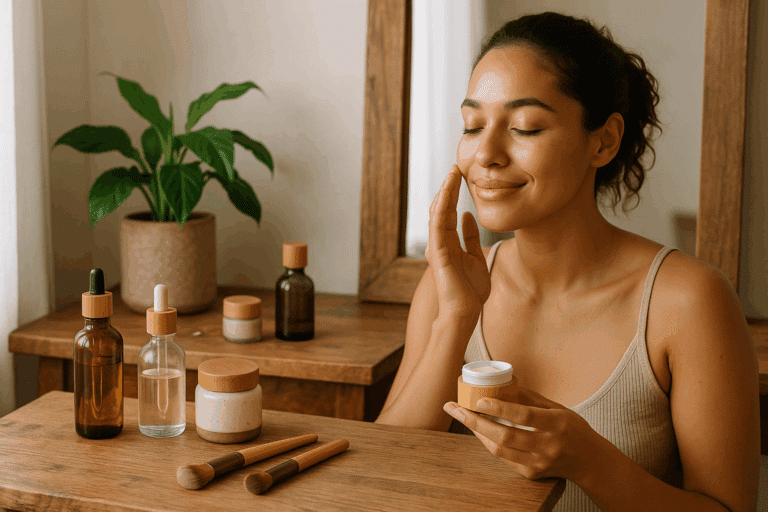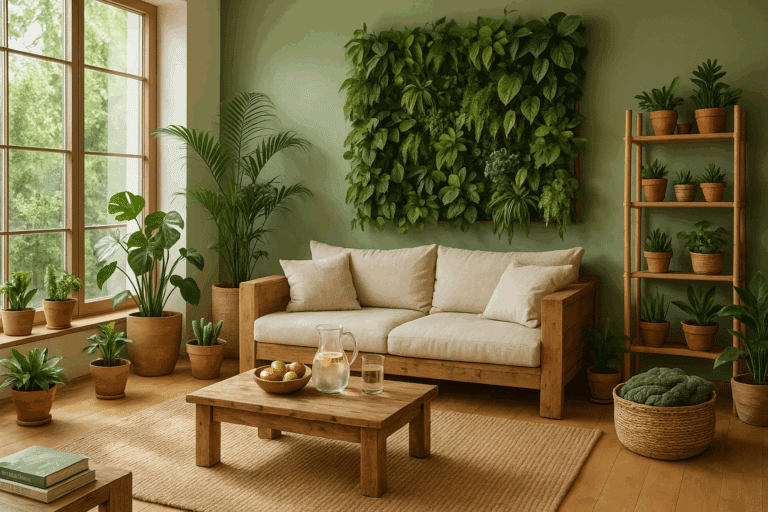The concept of “Bringing the Outdoors In: Transforming Your Space with Nature-Inspired Stencil Art” is all about inviting the tranquility of nature into your personal space by painting flora onto walls or pots.
This is not just about adding aesthetic appeal to your space. More than that, it’s about creating an atmosphere that resonates with peace, calm, and life-affirming energy. The gentle sweep of a leaf’s contour, the delicate veins of a petal, the symmetry of a snowflake, or the intricate patterns found in a tree’s bark – the possibilities are endless and captivating. 🌿

The process of transforming your space with nature-inspired stencil art is indeed a journey. It’s a journey of exploration, creativity, and the joy of seeing a simple space bloom into a serene sanctuary that reflects your appreciation for the natural world. This transformation is not just about the end result; it’s about the journey, the process, and the experience. 🎨
By the end of this, you’ll have the tools and knowledge needed to bring your walls to life with stenciled flora, transform ordinary pots into works of art, and create a nature-inspired haven within your very own space. The following segments will offer step-by-step guides, tips on selecting the right materials, and inspiration on designs that you can use as your blueprint or modify according to your personal preference.
Are you ready to embark on this journey? To bring the beauty, calm, and inspiration of the outdoors in? Let’s dive in and start transforming your space with nature-inspired stencil art. It’s time to paint the flora onto your walls or pots and bring the outdoors in! 🌼🍃🎨
Selecting the Ideal Flora for Stenciling
When choosing flora to stencil onto walls, pots, or other surfaces, the selection process goes far beyond simply picking your favorite plant. It’s important to consider how each type of plant fits into the broader context of your design scheme. For example, stenciling a tropical monstera leaf onto a pot intended for a Scandinavian minimalist space may result in an aesthetic mismatch. The success of your stencil art depends not only on execution but also on your ability to visualize how the flora aligns with the surroundings.
Let’s take a closer look at popular flora choices and the types of settings where they truly shine:
- Ferns: With their delicate fronds and timeless beauty, ferns bring elegance and subtle texture to both walls and containers. They’re an ideal choice for classic, country, and forest-inspired decor themes.
- Monstera Leaves: These bold and modern shapes are perfect for contemporary spaces and tropical-inspired settings. Their easily recognizable design adds drama and a sense of the exotic.
- Eucalyptus: Eucalyptus leaves, with their elongated and soft curves, create a calming, spa-like feel. They’re great for modern rustic and clean, white-washed interiors.
- Roses: A favorite for those wanting a vintage or romantic vibe, rose stencils work beautifully in shabby chic, Victorian, or French cottage styles. Their intricate details can make any space feel more intentional and personal.
- Lavender, Olive Branches, and Dandelions: These are additional examples of flora that lend themselves well to stenciling. Lavender gives off countryside charm, olive branches feel Mediterranean, and dandelions bring playfulness and whimsy.
When choosing your flora, also consider scale and color scheme. Larger leaf patterns may overwhelm a small pot, whereas tiny details may be lost on a textured wall. Always test your stencil against the backdrop before committing to a full design.
The Art of Stenciling
Stenciling is a method of painting that involves using a cut-out design to create a pattern or image. This technique is a brilliant way of introducing elements of nature into your home or office. However, to get the best results, it’s essential to understand the mechanics and nuances of stenciling.
Tools Required
Before starting, you’ll need a few specific tools:
- Stencil: You can purchase pre-made stencils or create your own.
- Paint: Acrylic paints are often used due to their quick drying time.
- Brushes: Use a stencil brush for best results.
- Tape: This helps to keep the stencil in place.
The Art of Stenciling: A Comprehensive Guide to Painting Flora on Walls and Pots
Understanding the Stenciling Process
Stenciling is a creative and accessible art technique that allows individuals to add personal flair and intricate patterns to various surfaces without requiring formal artistic training. Though the process is straightforward, achieving a clean and professional look demands attention to detail and a bit of practice.
At its core, stenciling involves placing a cut-out design over a surface and applying paint over the openings to replicate the pattern. It is commonly used in home décor, DIY projects, and artistic installations due to its versatility and simplicity.
Surface Preparation
Before you begin stenciling, it is essential to prepare your surface properly. This means ensuring the surface is free from dust, oils, and imperfections. A clean, smooth surface helps the stencil lay flat, which reduces the risk of paint seeping underneath and blurring the design. For walls or large surfaces, wipe the area with a damp cloth and allow it to dry thoroughly. For materials like terracotta or wood, sanding may be necessary to smoothen out rough textures.
Positioning the Stencil
Once the surface is clean, position the stencil with precision. Use painter’s tape or stencil adhesive spray to secure the stencil. The placement should align with your overall design plan, whether it involves repeating patterns or a single centerpiece motif. A level can help ensure straight positioning, especially for geometric or border designs.
Paint Application Techniques
The key to a crisp stencil design lies in the painting technique. Using a stencil brush or a sponge, dip lightly into the paint and then dab off any excess onto a paper towel or palette. This prevents paint overload, which can cause bleeding beneath the stencil. Apply the paint using a light, vertical dabbing motion. Avoid brushing side to side, as this can push paint under the stencil edges.
Multiple light coats are preferable to one heavy application. Let the first coat dry slightly before applying the next, if necessary. This layering approach helps create rich, vibrant results without compromising the integrity of the design.
Removing the Stencil
Remove the stencil carefully and promptly while the paint is still damp. Doing so reduces the risk of peeling or smudging. Pull the stencil away from the surface in one steady motion. If you plan to reuse the stencil, clean it immediately with mild soap and water or appropriate solvent, depending on the paint used.
Painting Flora onto Walls: Bringing Nature Indoors
Nature-inspired designs are a timeless way to refresh interiors. Painting flora onto walls brings warmth, organic beauty, and a calming atmosphere to any space. Flowers, leaves, vines, and trees can complement a wide variety of décor styles—from rustic to contemporary.
Planning Your Design
Start by envisioning the final look. Do you want a single large floral motif, a repeated vine pattern, or an accent border? Consider the room’s layout, lighting, wall color, and existing furniture. Subtle floral designs in soft hues can lend elegance to a bedroom or hallway, while bold tropical patterns might energize a kitchen or creative studio.
Sketch your ideas on paper or use digital design tools to visualize placement. You can also test stencil patterns on cardboard or poster board before committing to the wall.
Color Selection
Color plays a vital role in how the floral patterns will be perceived. Choose paint colors that contrast gently with the wall base to ensure visibility without overwhelming the space. Monochromatic tones work well in minimalist settings, while multicolor palettes can add vibrancy and depth.
Don’t hesitate to blend colors directly on the stencil. For instance, combining different greens can create realistic foliage, while varying petal shades can give flowers a more dimensional look.
Layering and Effects
Advanced stenciling can involve layering multiple stencils to build complex images. Start with background foliage, then overlay larger blooms or accent details. You may also use shading and dry brushing techniques to create shadow and texture effects. Adding metallic or pearl-finish paints can give the design a luminous touch, especially under lighting.
Preparation and Application on Walls
Before starting, prime the wall if the paint doesn’t adhere well or if you’re covering a dark color. Once the wall is ready, place your stencil and ensure it’s firmly attached to avoid movement during painting. Use a step ladder for higher areas and ensure proper ventilation when working indoors.
Apply the paint as described earlier—using minimal paint and a dabbing technique. Allow drying between repetitions, and use a clean stencil or duplicate if working with overlapping sections.
If you’re creating a large mural or repeating pattern, measure spacing carefully. A ruler, level, or grid lines drawn lightly in pencil can help maintain consistency.
Painting Flora onto Pots: Adding Character to Container Gardens
Terracotta, ceramic, plastic, or metal pots are ideal surfaces for flora-themed stenciling. Whether for indoor plants or patio décor, stenciled pots introduce personality and artistry to your green spaces.
Choosing the Right Pot
Not all pots are created equal for stenciling. The pot’s size and curvature affect how well a stencil will lay flat. Wide cylindrical pots work best. If your pot has a strong taper or complex shape, you might need to cut or bend the stencil slightly to conform to the surface.
Select a pot material compatible with your chosen paint. Acrylic paint works well on most surfaces, but for outdoor use, ensure you choose weather-resistant or sealable paint. For glazed ceramics, lightly sanding the area may help the paint adhere better.
Prepping the Pot
Clean the pot thoroughly to remove any dust, dirt, or residue. If it’s a new pot, washing with warm soapy water and drying completely will suffice. For reused pots, a deeper cleaning may be needed. After cleaning, apply a primer designed for the pot’s material if needed. Priming ensures even paint application and durability.
Applying Stencils to Pots
The stenciling process on pots is similar to walls but requires extra patience due to curved surfaces. Tape the stencil firmly or use repositionable spray adhesive. Some crafters recommend using elastic bands or clips to help hold stencils on rounded shapes.
Use a smaller brush or sponge to accommodate tighter areas. Apply paint slowly and sparingly. You might need to hold parts of the stencil down manually to avoid gaps, especially along curves.
Allow the paint to dry fully before handling the pot. Depending on the paint type, this can range from a few hours to overnight. To protect the design, consider sealing the pot with a clear waterproof spray sealant, especially if it will be placed outdoors.
Design Ideas for Wall and Pot Stenciling
- Botanical Wall Garden: Use various stencils to simulate a climbing vine from the base of the wall to the ceiling. Add layers of leaves and flowers in natural tones.
- Tropical Oasis: Large monstera or palm leaf stencils in bold greens can create a vibrant tropical feature wall.
- Delicate Florals: Small, repeating floral patterns in pastel tones can enhance nurseries, bathrooms, or reading corners.
- Herb Pots: Use herb-specific stencils (like basil, rosemary, thyme) on pots for a themed kitchen garden.
- Seasonal Themes: Customize pots or wall art for different seasons—cherry blossoms in spring, sunflowers in summer, autumn leaves in fall.
Tips for Successful Stenciling Projects
- Practice First: Try your technique on cardboard or scrap material to get a feel for the paint flow and stencil handling.
- Keep Tools Clean: Paint buildup on stencil brushes or the stencil itself can cause smudging. Clean tools between sessions or colors.
- Patience is Key: Rushing leads to errors. Allow each layer to dry completely, especially when creating complex or multi-colored designs.
- Use Quality Materials: Investing in good brushes, durable stencils, and reliable paint brands makes a noticeable difference in results.
- Protect the Final Work: A clear topcoat or sealant enhances durability and preserves your design against time and environmental wear.

Final Thoughts: Embracing Nature Through Artistic Expression
Flora-themed stencil art is more than just decoration—it is a way to reconnect with nature and express creativity within your personal space. Whether applied to expansive walls or small plant pots, these natural motifs offer a refreshing, harmonious aesthetic that uplifts the spirit and energizes the surroundings.
By understanding the tools, preparing the surfaces thoughtfully, and applying each layer of paint with care, anyone can create stunning stenciled art. The beauty lies not just in the finished piece but in the process itself—the meditative rhythm of painting, the joy of watching the design come to life, and the satisfaction of creating something unique and meaningful.
Explore different floral themes, try new color palettes, and don’t be afraid to mix techniques. With imagination and intention, your home can become a canvas for blooming creativity.
Conclusion
In conclusion, “Bring the Outdoors In: Transform Your Space with Nature-Inspired Stencil Art – Paint Flora Onto Walls or Pots!” offers a comprehensive guide to integrating natural elements into your living spaces. By utilizing the aesthetic appeal and tranquility of nature, this method provides a unique way to enhance your indoor environment.
With easy-to-follow steps and creative ideas, anyone can breathe new life into their surroundings by introducing natural motifs, whether on walls or pots. The concept not only serves as a design trend but also promotes a sense of well-being by creating a natural sanctuary within your home.
Furthermore, the nature-inspired stencil art allows for personalization and originality. Each piece can be a reflection of individual style, making every creation unique. The simplicity of this art form ensures that it is accessible to everyone, regardless of their artistic skill level.
In a world where we are increasingly confined indoors, bringing the outdoors in provides a refreshing escape. It connects us with nature, fosters relaxation, and cultivates a serene atmosphere. Hence, this creative endeavor is more than just a decoration; it is a lifestyle choice that promotes mindfulness and tranquility. So, go ahead, explore your creativity, and transform your space with nature-inspired stencil art. 🍃🎨



